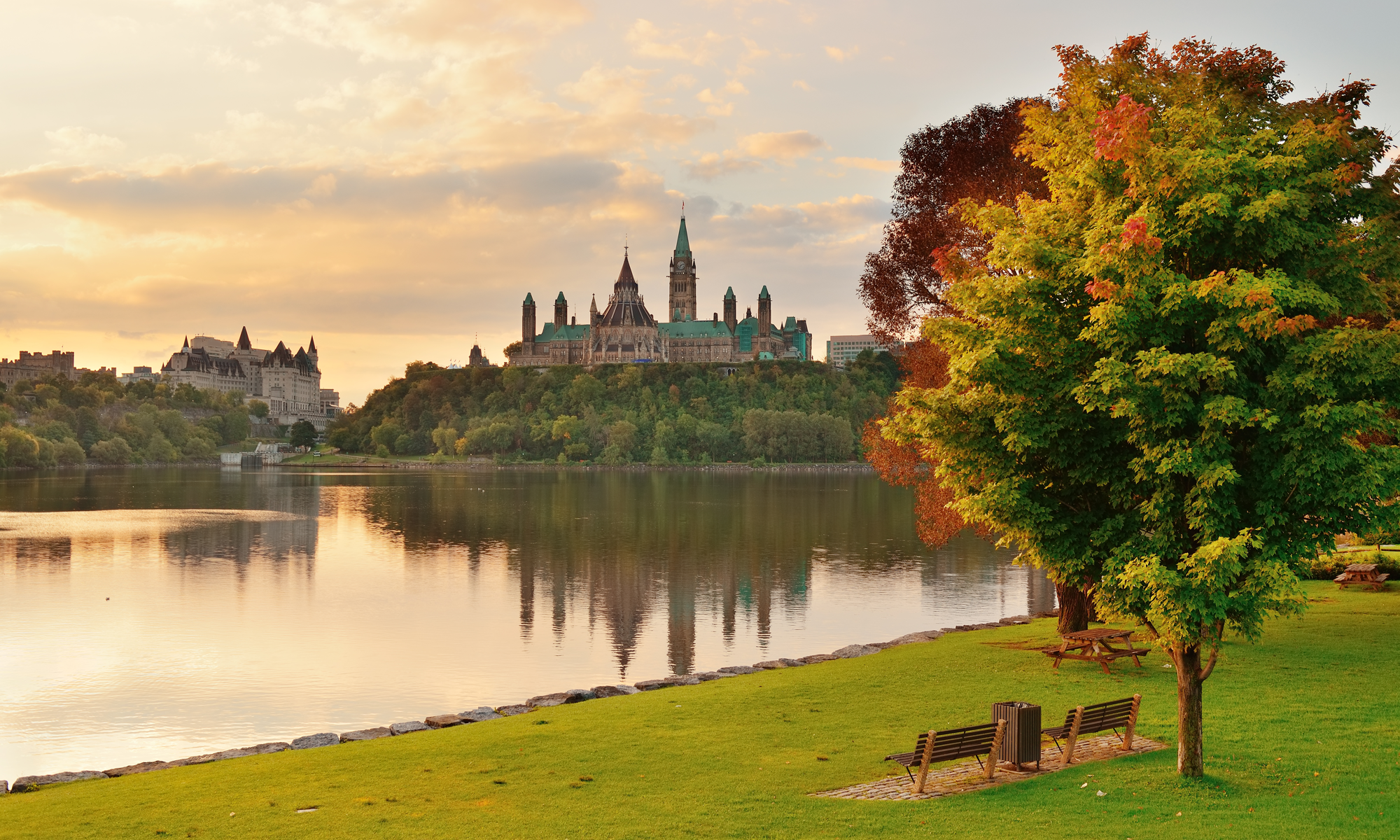Another interesting episode. This YouTube version has an audio problem for the final minute.
Military Monday
Here’s a perspective on UK and Canadian newspaper coverage of the First World War.
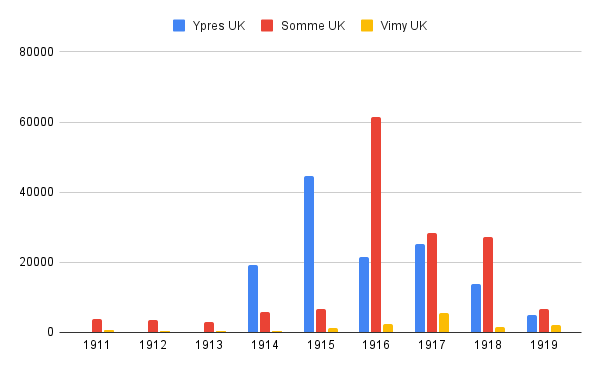 From the British Newspaper Archive, 1911 to 1919, counting occurrences of the terms Ypres, Somme and Vimy. Ypres was dominant in 1914 and 1915, Somme thereafter. Vimy gets its most mentions in 1917 with more in 1919 than 1918. Summed over the period Somme is mentioned more than Ypres.
From the British Newspaper Archive, 1911 to 1919, counting occurrences of the terms Ypres, Somme and Vimy. Ypres was dominant in 1914 and 1915, Somme thereafter. Vimy gets its most mentions in 1917 with more in 1919 than 1918. Summed over the period Somme is mentioned more than Ypres.
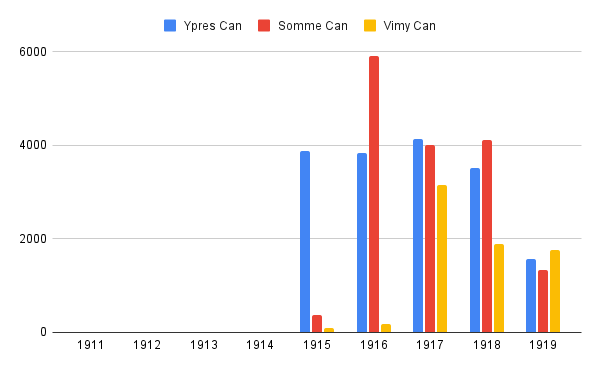
Canadian newspapers digitized by newspapers.com shows Ypres dominating in 1915, Somme in 1916, Vimy showing strongly from 1917, leading in occurrences in 1919. The absolute numbers are less for Canada than the UK reflecting population and the extent of the database.
The validity of these data depends on the quality of the OCR.
Advice to LAC
Did you know Library and Archives Canada has a Youth Advisory Council? It has 22 members, age 19 to 25 with the current terms running from February 2021 to June 2022. According to the LAC information on the Council, “members discuss a variety of topics related to Canada’s documentary heritage and contribute to LAC management decisions by providing fresh perspectives and innovative ideas.”
This word cloud derived from the individual members summary gives a window on the Council member’s background and interests. 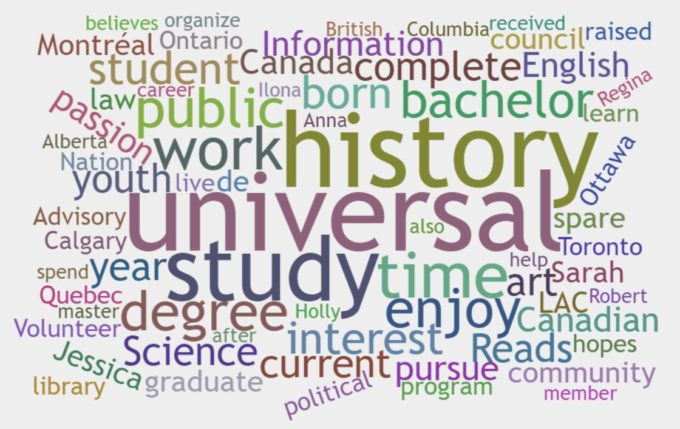
There’s no information on the LAC website about any recent Youth Advisory Council meetings.
Other advisory committees and mechanisms are:
Acquisitions Advisory Committee, most recent information on meetings is December 2018;
Indigenous Advisory Circle, no information on meetings;
LAC Forum with University Partners, last meeting March 2019;
LAC foundation, the latest information is September 2021;
Official Language Minority Communities, mentions a conference in 2021 – no further information;
Services Consultation Committee, last information May 2019;
Friends of Library and Archives Canada – no recent information.
Is LAC just not updating the website, or maybe management has lost interest in these mechanisms for accessing external advice?
Sunday Sundries
Miscellaneous items I found of interest during the week.
Hidden branches in Joe Biden’s family tree
Records of enslaved people – Derbyshire
Women in the War – a new LAC Co-Lab challenge
Thanks to this week’s contributors. Barbara, Brenda Turner, Donna, Gail Benjafield, Glenn Wright, Patte Wood
RQG Conference
You have until the end of the month to view the presentations given at the Register of Qualified Genealogists conference. Don’t miss the free opportunity.
What genealogists and social historians can learn from each other.
Caroline Gurney
Finding your ancestors at home: researching the history of houses.
Melanie Backe-Hansen
Business histories putting our ancestors into their commercial communities.
Elizabeth Walne
Who was Kastian Richardson? From family story to theatrical social history.
Diana Nicoll
Researching criminal ancestors.
Prof. Helen Johnston and Prof. Heather Shore
Dusting and Digging: The work of women, 1796-1829.
Valerie Brenton
Life of the Early Victorian Deaf and Dumb (A Yorkshire Study).
Anne Sherman
Hidden history: Tales of everyday life in Newspaper Advertisements.
Audrey Collins
Jilted! Or the insights offered in a breach of contract of marriage cases.
Kate Keter
Lying Bastards: the impact of illegitimacy on family history research.
Dave Annal
Glenn Wright presentation to OGS Ottawa Branch
Today, Saturday 23 Oct 2021 01:00 PM Eastern Time (US and Canada)
Title: Silent No More: Researching Our Great War Dead
Speaker: Glenn Wright
Details: Documenting fatal casualties was an enormous undertaking during and immediately after the Great War. One of the first illustrated guides to the cemeteries in France and Belgium was Sidney C. Hurst’s Silent Cities, published in 1929. Now, more than a century after the war ended and with easy access to personnel records, we can break the silence and tell the story of our ancestors who served and died in the war. With the proliferation of online information, including death and burial documentation, newspapers and community-based research, we can document our war dead as never before. This presentation will look at the development of memorials and cemeteries and, more importantly, will review the major resources, well-known and not so well-known, that are available online and elsewhere, for researching Canada’s Great War dead.
You are invited to a Zoom meeting.
Register in advance for this meeting:
https://us02web.zoom.us/meeting/register/tZ0rcumvpj0tHdKSD49Y6zPjh5uBf5ANTLVe
All Ottawa Branch monthly presentations are open to the public at no charge.
FreeBMD October update
The FreeBMD Database was updated on Friday 22 October 2021 to contain 282,373,129 unique entries, increased from 281,999,667 at the previous update.
Years with changes of more than 10,000 records since the last update are: for births 1886-87, 1990-92; for marriages 1986-87, 1989-91; for deaths 1988-90.
Findmypast Weekly Update
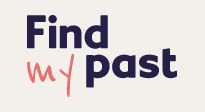 This week FMP added new records for the Plymouth Diocese and thousands of additional records from the Southwark Archdiocese to the England Roman Catholic Parish Records collection.
This week FMP added new records for the Plymouth Diocese and thousands of additional records from the Southwark Archdiocese to the England Roman Catholic Parish Records collection.
These records for 1781-1921 include:
Over 55,000 baptism records
Over 16,000 marriage records
Over 15,000 burial records
Over 15,000 congregational records
There are now 2,584,958 records in the Catholic collection for England.
The Breadbasket of England
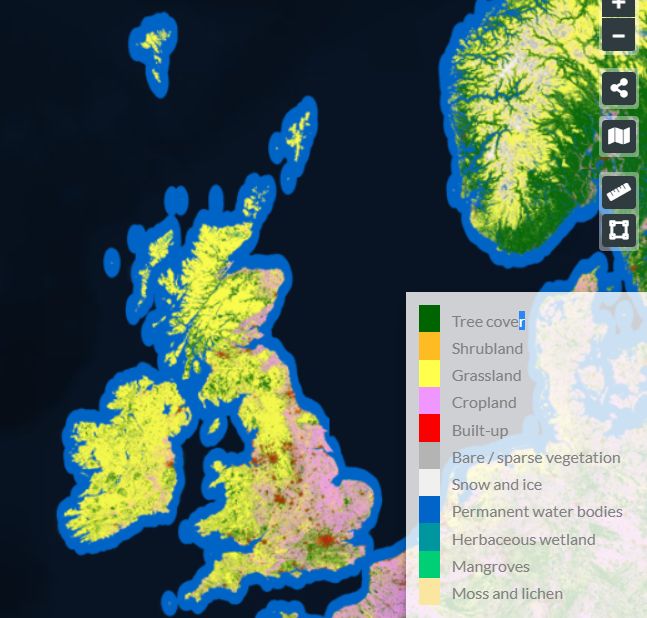
Having been raised there I shouldn’t have been as surprised as I was to see the dominance of Eastern England, especially East Anglia when it comes to cropland.
As the ESA WorldCover Viewer map provides data on land cover at 10 m resolution across the whole world you can get in close to a place of interest. The map distinguishes 11 different classes of land cover, including tree cover, grassland, cropland and built-up land.
via Maps Mania.
Ancestry adds All United States Patent and Trademark Office, U.S. Patents, 1970-2019
Another unusual genealogy database. The search screen is conventional headed by boxes for First & Middle Name(s) and Last Name. There’s also a Keyword search.
Searching for “ancestry” returns 128 results, “genealogy” 124 results, and for “family history” 20. The information returned is sparse: Name, Residence Place, Application Date, Certificate Number and Others Listed. No further detail is linked.
The top places associated with the “genealogy” patents were: Utah (38), Colorado (25), Massachusetts (12), Canada (10), Alabama (5). Surprised?
You might also be surprised by where in Canada these US “genealogy” patents were filed from — BC (8 in the Lower Mainland), Quebec (2 in Beaconsfield).
MyHeritage half-off for new subscribers
 Do you qualify? MyHeritage’s best plan for discovering family history — which gives you access to all records and tools, is for Legacy users who are not currently subscribers of MyHeritage. It includes a unique Price-Lock Guarantee. This means you will be able to continue to enjoy the Complete Plan for the same 50% discounted price for as long as you keep your subscription.
Do you qualify? MyHeritage’s best plan for discovering family history — which gives you access to all records and tools, is for Legacy users who are not currently subscribers of MyHeritage. It includes a unique Price-Lock Guarantee. This means you will be able to continue to enjoy the Complete Plan for the same 50% discounted price for as long as you keep your subscription.
If you’re an existing subscriber cancel before the end of the term. Then wait for a discount offer. It won’t take long.
The offer expires on October 25, 2021.
Postmortum records for London’s St George’s Hospital
 Old postmortem records for St George’s Hospital, in 76 volumes from 1841 to 1946, an estimated total of 36,000 cases, are freely available online. Most patients were from the lower classes.
Old postmortem records for St George’s Hospital, in 76 volumes from 1841 to 1946, an estimated total of 36,000 cases, are freely available online. Most patients were from the lower classes.
A blog post illustrates the type of information of interest for family history that may be found. For example, Albert Pratt, a four-year-old boy who died on 20 August 1889.
His parents lived at Brighton but the child had been staying at 1A Bulmer Place Notting Hill Gate. In this house the floor of the W.C. [Water Closet] was in a very bad state, having all crumbled away. The Landlord refusing to do anything. Within the last 6 weeks 6 persons living in the house, 4 children and 2 young women had had sore throats but all recovered.’ Young Albert, was diagnosed with Diphtheria and ultimately succumbed to the illness.
The project to conserve, digitise and catalogue the postmortum records, funded by the Wellcome Foundation, is in progress with records to about 1920 complete.
Browse or search the collection from https://archives.sgul.ac.uk/post-mortem-examinations-and-case-books/.
